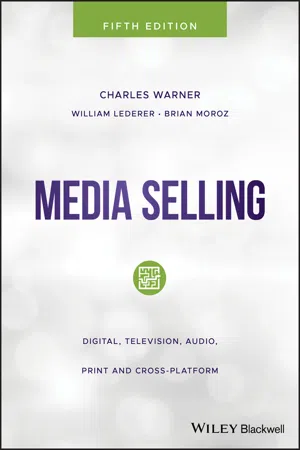
Media Selling
Digital, Television, Audio, Print and Cross-Platform
- English
- ePUB (mobile friendly)
- Available on iOS & Android
Media Selling
Digital, Television, Audio, Print and Cross-Platform
About this book
The must-have resource for media selling in today's technology-driven environment
The revised and updated fifth edition of Media Selling is an essential guide to our technology-driven, programmatic, micro-targeted, mobile, multi-channel media ecosystem. Today, digital advertising has surpassed television as the number-one ad investment platform, and Google and Facebook dominate the digital advertising marketplace. The authors highlight the new sales processes and approaches that will give media salespeople a leg up on the competition in our post-Internet media era.
The book explores the automated programmatic buying and selling of digital ad inventory that is disrupting both media buyers and media salespeople. In addition to information on disruptive technologies in media sales, the book explores sales ethics, communication theory and listening, emotional intelligence, creating value, the principles of persuasion, sales stage management guides, and sample in-person, phone, and email sales scripts. Media Selling offers media sellers a customer-first and problem-solving sales approach. The updated fifth edition:
- Contains insight from digital experts into how 82.5% of digital ad inventory is bought and sold programmatically
- Reveals how to conduct research on Google Analytics
- Identifies how media salespeople can offer cross-platform and multi-channel solutions to prospects' advertising and marketing challenge
- Includes insights into selling and distribution of podcasts
- Includes links to downloadable case studies, presentations, and planners on the Media Selling website
- Includes an extensive Glossary of Digital Advertising terms
Written for students in communications, radio-TV, and mass communication, Media Selling is the classic work in the field. The updated edition provides an indispensable tool for learning, training, and mastering sales techniques for digital media.
Frequently asked questions
- Essential is ideal for learners and professionals who enjoy exploring a wide range of subjects. Access the Essential Library with 800,000+ trusted titles and best-sellers across business, personal growth, and the humanities. Includes unlimited reading time and Standard Read Aloud voice.
- Complete: Perfect for advanced learners and researchers needing full, unrestricted access. Unlock 1.4M+ books across hundreds of subjects, including academic and specialized titles. The Complete Plan also includes advanced features like Premium Read Aloud and Research Assistant.
Please note we cannot support devices running on iOS 13 and Android 7 or earlier. Learn more about using the app.
Information
1
The Marketing/Media Ecology
What Is Marketing?
Table of contents
- Cover
- Table of Contents
- Media Selling
- About the Authors
- Acknowledgments
- Preface
- 1 The Marketing/Media Ecology
- 2 Selling in the Digital Era
- 3 Sales Ethics and Transparency
- 4 The AESKOPP Approach, Attitude, and Goal Setting
- 5 Emotional Intelligence
- 6 Effective Communication, Effective Listening, and Understanding People
- 7 Influence and Creating Value
- 8 The New Buying and Selling Process
- 9 Prospecting and Qualifying
- 10 Researching Insights and Solutions
- 11 Educating
- 12 Proposing
- 13 Negotiating and Closing
- 14 Customer Success
- 15 Marketing
- 16 Advertising
- 17 Programmatic Marketing and Advertising
- 18 Measuring Advertising
- 19 Selling Digital and Cross‐Platform Advertising
- 20 Google and Search
- 21 Facebook and Social Media
- 22 Television
- 23 Print and Out of Home
- 24 Audio
- 25 Time Management
- Appendix: Digital Advertising Glossary
- Index
- End User License Agreement